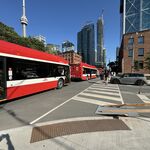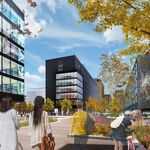W. K. Lis
Superstar
Or this double decker train?
Or this double decker train?
Where are all the studies on RER, period? ML is building the whole thing behind closed doors with none of the transparent diligence that City projects get. Sure, one hates to see the duelling studies dynamics of the City's politics, but that is preferable to making decisions with no data or debate at all. The recent Davenport debacle is a good example of this, it came out of nowhere and blindsided everyone. The powerpoint decks that accompany RER town hall meetings are hugely vague, compared to say the Crosstown EA document.
- Paul
The studies are ongoing and are coming or did you expect the studies to already be in place. With the Crosstown, there was a proposal done first, then the studies and EA came later. I don't know why you are expecting any different. There are already business case analysis for increased go expansion here:
http://www.metrolinx.com/en/regiona.../benefitscases/Benefits_Case-GO_Lakeshore.pdf
http://www.metrolinx.com/en/regiona...ation/benefitscases/Benefits_Case-GO_Rail.pdf
And numerous documents from Metrolinx board meetings about GO RER here:
TBM tunnels are completely removed where a station is built, the tunnel at North York Centre was built differently and allowed for the tunnel walls to be cut away leaving the bottom and trackbed in place.
There are several ways you can "prep" to build a station in an area that minimally affect the costs of the subway.
Emergency exits and ventilation shafts will be needed on the 6km line.
What you do is that you design these ventilations and emergency exits in a way that a station is basically "roughed in" for later use.
This is actually what was done on the Finch subway line extension in the 1970's: North York Centre was a planned station stop in the beginning, and along with other stations (there was supposed to be stops between Eglinton and Lawrence and Lawrence and York Mills station) it was scrapped. However, mayor Mel Lastman convinced the TTC to at least build a rough in for the station to be added at a later date.
So it was always planned to happen from the beginning.
They could do this on the Line 2 extension at several key points along the line, basically making all the emergency exits at major intersections or wherever they envision a station to be needed in the future.
Steve Munro has a new op-ed piece in the Toronto Sun about SmartTrack:
http://www.torontosun.com/2016/01/24/backtracking-on-smarttrack
A roughed in emergency exit that could be re purposed as a station would have to be structurally as large as a regular station platform anyway, there can't be much difference in cost compared with a finished station.
"Metrolinx has not commented yet, but an engineer at the briefing cautioned that rail corridors might not be wide enough in places."
How much of a challenge is it to widen these?
I'm a bit ignorant on the construction differences between a working line and one not built yet. Here is my thoughts and please correct them:
TBM bores the line including using a concrete liner from entrance to exit shaft
They close the road where the station will be and dig a huge hole
They cut out the concrete that was installed as part of the TBM bore
They create platforms and all the station build-out
They lay tracks
Station is done
So the only difference I see with a working line:
- the dig-out has to occur when the line is shut (risk of concrete collapse)
- the TBM concrete removal would be done after they complete the station build-out (carefully when the tracks are closed)
- the final subway edge platform has to be built as the last step
I really don't see the large technical challenge. Am I missing something?

"Metrolinx has not commented yet, but an engineer at the briefing cautioned that rail corridors might not be wide enough in places."
How much of a challenge is it to widen these?




